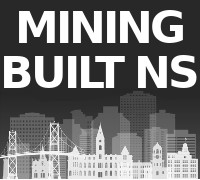- Why Mining Matters
- Jobs
- Safety
- Environment & Operations
- FAQ
- Links
- Fun Stuff
You are here

Gallihar and Dimock
Mr. Death
The Guilty Grenos
James Mitchell
Hugh McAskill
Gold Grows Under Shrubs?
Unexploded Dynamite
Tangier’s John Murphy
Joe Howe Dimock
Chats with Pioneer Miners
Charles Annand
John Scott Williams
Nicholas Fitzgerald
Chief Lonecloud
Pistols and Gold Mines
James MacDonald’s Thefts
John Vaughn
Herbert Dixon and the Halifax Explosion
James Bishop
Neily's Scandals
Waverley in 1934
Discovery of Gold at Dufferin
Hurricane Island
Fletcher and Faribault
Jack Munroe
Mine Apprentice Project
Small Gold Districts
15 Mile Stream
Tributers
E. Percy Brown and the Brookfield Mine
Barachois
Nova Rich Mines
Shad Bay Treasure Hunt
Montague 1937 Accident
Father Lanigan’s “Prospect”
George V. Douglas
The Stewart Brothers
Goldboro
Moose River's Touquoy Mine
Camerons Mountain
Jim Campbells Barren
Stanburne's Puzzling Gold Mine
Pockwock
Beaverbank Lake
Banook Mining Company
Deep Gold Mining
Wellington
Arsenic and Gold
Dynamite
War of Words
King of the Klondike
Oliver Millett
Kempt Gold Mining Company
Carleton
The Memramcook Fiasco
Love and Gold in Oldham
Montague 1893 Disaster
Central Rawdon Consolidated Mines
Cochrane Hill
Amateurish Early Gold Mining
Sable Island Gold
The Sea Wolf
Trueman Hirschfield
Alexander Heatherington
Prospector Joe Cope
Killag Quicksand
George W. Stuart
Wellington
Billy Bell
Cooper Jim Mine
South Branch Stewiacke
Walter Prest
Lake Charlotte
Acadia Powder Mills Company
The Ovens Anticline
Moose River Anticline
Avon Mine Explosion
Montague
Waverley Claims Dispute
Avon River
Moose River Disaster
Mooseland Scam
New York and Nova Scotia Gold Mining Company
Rosario Siroy and the South Uniacke Gold District
Blockhouse
Killag Gold District
Miller Lake
Baron Franz von Ellershausen
Mooseland: Nova Scotia’s first Gold Discovery
United Goldfields of Nova Scotia
Pleasant River Barrens Gold District
Lochaber Gold Mining Company
Rawdon Gold Mines
MacLean Brook
Gold in Clayton Park?!
Forest Hill
Meguma vs. Placer Gold
Uniacke
Voglers Cove
Gold River
Moosehead
Goldenville
Westfield
Indian Path
Harrigan Cove
Centre Rawdon
Nova Scotia’s Gold Mining History
WWII Gold
Middle River Gold District
Early Gold Discoveries
Halifax 1867
Paris Exhibition 1867
Mining and Tourism
An Act relating to the Gold Fields
Molega Gold District
Brookfield Gold District
Gays River
Halifax Gold
Caribou Gold District
Renfrew Gold District
Oldham Gold District
Whiteburn Gold District
Country Harbour Mines
Waverley Gold District
Robert Henderson and Klondike Gold
George Mercer Dawson
Cow Bay Gold District
Lake Catcha Gold District
Wine Harbour Gold District
Whiteburn Gold District
A rising tide lifts all boats. That’s as true today as it was in the late 1880s when 20 years of gold mining in the Whiteburn Gold District played a key role in building Northern Queens County.
Gold was discovered in Whiteburn, six miles southwest of Caledonia, in 1885. According to reports, a forest fire ravaged the area and uncovered the gold. Jim McGuire, supposedly hiding out from the tax collector, found it in the barrens near his home and triggered the Whiteburn gold rush. It’s said that he registered the find in his brother’s name and hid his earnings - $5000 in the first year - in the floorboards of his cousin’s house to throw the authorities off his trail.
By 1887 three mines and mills were operating and mining continued until 1905.
The economic activity from mining didn’t just benefit miners. It created what we now call spinoff jobs and economic growth in the area. The miners bought food from local farmers. Jobs were created in forestry because timber was needed for homes, stores, a school, hotels, the mines and other buildings. Wood was also burned for heat and cooking in homes and to power mining equipment. Labourers and carpenters were needed to do the building.
Farmers were particularly big beneficiaries of the mines. Besides selling food to miners and the growing population – Whiteburn grew to 1000 people - a railway built in 1903 to service the mines became important infrastructure that allowed crops and lumber to be sent by rail instead of cart paths. Fresh vegetables, fruits and meat could now be in Bridgewater in just a few hours. The railway also increased access to machinery, chemicals and other modern agricultural supplies.
According to a 1977 federal government report, because of the gold mines “men, machinery, and capital flowed into the area. This tide did not diminish for 20 years and even when it did it left pools of experience and wealth.”
Modern mines and quarries also have this sort of broad, positive economic impact. Some Nova Scotia mines and quarries have been operating and employing Nova Scotians for well over half a century and are economic pillars of their communities.
But operations that have shorter lifespans are still important to their host communities and the province in general. For example, the modern Moose River (Touquoy) gold mine extracted from 2017-23, creating over 300 direct jobs and over 900 spinoff jobs. The average salary at the mine was $84,000 per year. It generated $7.4 million in provincial tax revenue, $3.7 million in municipal tax revenue, and $100 million in economic spinoffs to local businesses. The company donated $1.6 million to community and non-profit organizations.
Environmentally, the Moose River mine was an excellent example of how modern mining is completely different from what it was historically. The mine remediated two historical mine sites and 61,000 tonnes of contaminated soil from past operations by digging them up and moving them into the modern mine’s tailings facility, where they can no longer interact with the environment.
The pictures below show an old safe, claim marker and boiler in Whiteburn.

















































































